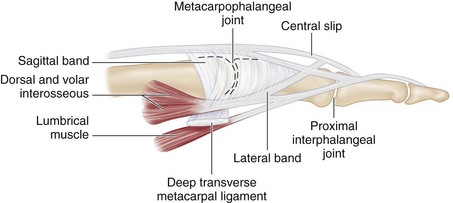Procedure 35 Silicone Metacarpophalangeal Joint Arthroplasty
![]() See Video 27: Silicone Metacarpophalangeal Joint Replacement Arthoplasty for Rheumatoid Arthritis
See Video 27: Silicone Metacarpophalangeal Joint Replacement Arthoplasty for Rheumatoid Arthritis
Examination/Imaging
Clinical Examination
 The patient’s MCP joints should be evaluated for range of motion and stability. If the MCP joints are not dislocated but the fingers are drifted ulnarly, intrinsic transfer may be performed to correct the finger misalignment for the small, ring, and long fingers; the radial sagittal band of the index finger is tightened to centralize its extensor tendon because no ulnar intrinsic tendon is available for transfer.
The patient’s MCP joints should be evaluated for range of motion and stability. If the MCP joints are not dislocated but the fingers are drifted ulnarly, intrinsic transfer may be performed to correct the finger misalignment for the small, ring, and long fingers; the radial sagittal band of the index finger is tightened to centralize its extensor tendon because no ulnar intrinsic tendon is available for transfer.
 With chronic subluxation of the MCP joints, ligamentous contracture around the joints cannot be corrected by soft tissue reconstruction alone. MCP joint arthroplasty is the preferred option in most of these cases.
With chronic subluxation of the MCP joints, ligamentous contracture around the joints cannot be corrected by soft tissue reconstruction alone. MCP joint arthroplasty is the preferred option in most of these cases.
 The thumb MCP joint laxity should be assessed, which is best treated with MCP joint fusion at the time of silicone MCP arthroplasty (SMPA).
The thumb MCP joint laxity should be assessed, which is best treated with MCP joint fusion at the time of silicone MCP arthroplasty (SMPA).
 For patients who have collapse of the wrists and radial deviation of the metacarpals, the wrist problem should be addressed first either by fusion or by arthroplasty. Otherwise, the radial deviation of the metacarpals will cause early postoperative ulnar subluxation of the fingers after SMPA. Realigning the metacarpals by means of the wrist procedures will enhance the outcome of SMPA.
For patients who have collapse of the wrists and radial deviation of the metacarpals, the wrist problem should be addressed first either by fusion or by arthroplasty. Otherwise, the radial deviation of the metacarpals will cause early postoperative ulnar subluxation of the fingers after SMPA. Realigning the metacarpals by means of the wrist procedures will enhance the outcome of SMPA.
Surgical Anatomy
 The MCP joint is a condylar joint that allows flexion and extension but also radial and ulnar deviation.
The MCP joint is a condylar joint that allows flexion and extension but also radial and ulnar deviation.
 The radial and ulnar sagittal bands stabilize the extensor tendon, keeping it over the dorsal midline of the MCP joint. The sagittal bands are attached to the volar plate.
The radial and ulnar sagittal bands stabilize the extensor tendon, keeping it over the dorsal midline of the MCP joint. The sagittal bands are attached to the volar plate.
 The lateral bands pass volar to the MCP joint and dorsal to the proximal interphalangeal (PIP) joint. Contraction of the intrinsic muscles through the lateral bands causes MCP joint flexion and PIP joint extension (Fig. 35-1).
The lateral bands pass volar to the MCP joint and dorsal to the proximal interphalangeal (PIP) joint. Contraction of the intrinsic muscles through the lateral bands causes MCP joint flexion and PIP joint extension (Fig. 35-1).
 The cause of tendon subluxation at the MCP joint in RA is joint synovitis altering the ligamentous support in the joint. The hypertrophic synovial tissue distends the ligamentous support of the joint, resulting in stretching of the radial and ulnar sagittal bands. Forceful gripping in daily activity tasks stresses the radial sagittal band, resulting in weakening of the radial support.
The cause of tendon subluxation at the MCP joint in RA is joint synovitis altering the ligamentous support in the joint. The hypertrophic synovial tissue distends the ligamentous support of the joint, resulting in stretching of the radial and ulnar sagittal bands. Forceful gripping in daily activity tasks stresses the radial sagittal band, resulting in weakening of the radial support.
 Progressive ulnar subluxation of the extensor tendons causes the ulnar drift seen in RA hands.
Progressive ulnar subluxation of the extensor tendons causes the ulnar drift seen in RA hands.
 Chronic ulnar subluxation of the extensor mechanism results in ulnar lateral band contracture, which eventually causes fixed contracture of the ulnar lateral bands.
Chronic ulnar subluxation of the extensor mechanism results in ulnar lateral band contracture, which eventually causes fixed contracture of the ulnar lateral bands.











